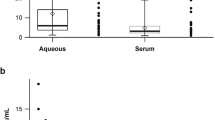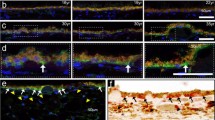Abstract
Purpose
To evaluate the cytotoxic effects of alteplase, a recombinant tissue plasminogen activator, and its additives on human retinal pigment epithelial (hRPE) cells.
Study design
Laboratory study.
Methods
We evaluated the cytotoxic effects of alteplase on human fetal RPE (hfRPE) cells, human induced pluripotent stem cell-derived RPE (hiPS-RPE), and ARPE-19 cells, as well as the cytotoxic effects of L-arginine and polysorbate 80, two additives of alteplase, on hfRPE cells. The effects of alteplase on the production of vascular endothelial growth factor (VEGF) and pigment epithelium-derived factor (PEDF) from hfRPE cells and the transepithelial resistance (TER) of hiPS-RPE cells were also assessed. The type of cell death induced by alteplase was investigated using ethidium homodimer III and FITC-Annexin V staining and terminal transferase deoxyuridine triphosphatase nick-end labeling.
Results
Alteplase reduced the viability of hfRPE cells significantly in a dose- and time-dependent manner. The reaction of hiPS-RPE and ARPE19 cells to alteplase was similar to that of hfRPE cells. Out of L-arginine and polysorbate 80, only treatment with L-arginine significantly reduced the viability of hfRPE cells. Alteplase (83 μg/ml, 6 h) had no significant effect on the production of VEGF and PEDF from hfRPE cells. Alteplase decreased the TER of hiPS-RPE cells in a dose- and time-dependent manner and induced necrosis as the type of cell death.
Conclusion
Alteplase can be cytotoxic to human RPE cells in a concentration- and time-dependent manner, with L-arginine being a possible causative factor.








Similar content being viewed by others
References
Haupert CL, McCuen BW, Jaffe GJ, Steuer ER, Cox TA, Toth CA, et al. Pars plana vitrectomy, subretinal injection of tissue plasminogen activator, and fluid-gas exchange for displacement of thick submacular hemorrhage in age-related macular degeneration. Am J Ophthalmol. 2001;131:208–15.
Kimura S, Morizane Y, Matoba R, Hosokawa M, Shiode Y, Hirano M, et al. Retinal sensitivity after displacement of submacular hemorrhage due to polypoidal choroidal vasculopathy: effectiveness and safety of subretinal tissue plasminogen activator. Jpn J Ophthalmol. 2017;61:472–8.
Inoue M, Shiraga F, Shirakata Y, Morizane Y, Kimura S, Hirakata A. Subretinal injection of recombinant tissue plasminogen activator for submacular hemorrhage associated with ruptured retinal arterial macroaneurysm. Graefes Arch Clin Exp Ophthalmol. 2015;253:1663–9.
Doi S, Kimura S, Morizane Y, Hosokawa MM, Shiode Y, Hirano M, et al. Adverse effect of macular intraretinal hemorrhage on the prognosis of submacular hemorrhage due to retinal arterial macroaneurysm rupture. Retina. 2020;40:989–97.
Kadonosono K, Arakawa A, Yamane S, Inoue M, Yamakawa T, Uchio E, et al. Displacement of submacular hemorrhages in age-related macular degeneration with subretinal tissue plasminogen activator and air. Ophthalmology. 2015;122:123–8.
Johnson MW, Olsen KR, Hernandez E, Irvine WD, Johnson RN. Retinal toxicity of recombinant tissue plasminogen activator in the rabbit. Arch Ophthalmol. 1990;108:259–63.
Hrach CJ, Johnson MW, Hassan AS, Lei B, Sieving PA, Elner VM. Retinal toxicity of commercial intravitreal tissue plasminogen activator solution in cat eyes. Arch Ophthalmol. 2000;118:659–63.
Hesse L, Schmidt J, Kroll P. Management of acute submacular hemorrhage using recombinant tissue plasminogen activator and gas. Graefes Arch Clin Exp Ophthalmol. 1999;237:273–7.
Chen S-N, Yang T-C, Ho C-L, Kuo YH, Yip Y, Chao AN. Retinal toxicity of intravitreal tissue plasminogen activator: case report and literature review. Ophthalmology. 2003;110:704–8.
Kimura S, Morizane Y, Hosokawa M, Shiode Y, Kawata T, Doi S, et al. Submacular hemorrhage in polypoidal choroidal vasculopathy treated by vitrectomy and subretinal tissue plasminogen activator. Am J Ophthalmol. 2015;159:683–9.
Oh H-S, Kwon OW, Chung I, Lee SC, Koh HJ, Lee S-H, et al. Retinal toxicity of commercial tissue plasminogen activator is mediated by the induction of nitric oxide in the mouse retinal primary cells. Curr Eye Res. 2005;30:291–7.
Kim US, Oh HS, Oh WK, Chung I, Lee SH, Lee JH. Effect of amiloride to retinal toxicity induced by tissue plasminogen activator. Korean J Ophthalmol. 2012;26:378–85.
Kamao H, Miki A, Kiryu J. Evaluation of retinal pigment epithelial cell cytotoxicity of recombinant tissue plasminogen activator using human-induced pluripotent stem cells. J Ophthalmol. 2019;2019:7189241.
Kosmidou C, Efstathiou NE, Hoang MV, Notomi S, Konstantinou EK, Hirano M, et al. Issues with the specificity of immunological reagents for NLRP3: implications for age-related macular degeneration. Sci Rep. 2018;8:461.
Kamao H, Mandai M, Okamoto S, Sakai N, Suga A, Sugita S, et al. Characterization of human induced pluripotent stem cell-derived retinal pigment epithelium cell sheets aiming for clinical application. Stem Cell Reports. 2014;2:205–18.
Kimura S, Morizane Y, Hosokawa MM, Shiode Y, Doi S, Hosogi M, et al. Outcomes of vitrectomy combined with subretinal tissue plasminogen activator injection for submacular hemorrhage associated with polypoidal choroidal vasculopathy. Jpn J Ophthalmol. 2019;133:639–47.
Samuel W, Jaworski C, Postnikova OA, Kutty RK, Duncan T, Tan LX, et al. Appropriately differentiated ARPE-19 cells regain phenotype and gene expression profiles similar to those of native RPE cells. Mol Vis. 2017;23:60–89.
Suzuki S, Kasai S, Mizuo H, Mizui K, Nagaoka N, Kikuchi K, et al. A comparative study of clot affinity and fibrinolytic and fibrinogenolytic properties of E6010 with rt-PA(Alteplase) and Urokinase. Jpn Pharmacol Ther Assoc Res Vision Ophthalmol. 1994;60:4811–9.
Fine HF, Iranmanesh R, Del Priore LV, Barile GR, Chang LK, Chang S, et al. Surgical outcomes after massive subretinal hemorrhage secondary to age-related macular degeneration. Retina. 2010;30:1588–94.
Acknowledgements
We thank Nobue Mukai and Kumiko Kikuchi and Shiori Ikeda for their excellent technical assistance.
Author information
Authors and Affiliations
Corresponding author
Ethics declarations
Conflicts of interest
S. Kimura, None; Y. Morizane, None; S. Toshima, None; Y. Shiode, None; S. Doi, None; K. Takahashi, None; R.Matoba, None; Y. Kanzaki, None; F. Shiraga, None.
Additional information
Publisher's Note
Springer Nature remains neutral with regard to jurisdictional claims in published maps and institutional affiliations.
Corresponding Author: Yuki Morizane
About this article
Cite this article
Kimura, S., Morizane, Y., Toshima, S. et al. Cytotoxic effects of alteplase, a recombinant tissue plasminogen activator, on human retinal pigment epithelial cells. Jpn J Ophthalmol 65, 731–739 (2021). https://doi.org/10.1007/s10384-021-00848-2
Received:
Accepted:
Published:
Issue Date:
DOI: https://doi.org/10.1007/s10384-021-00848-2




